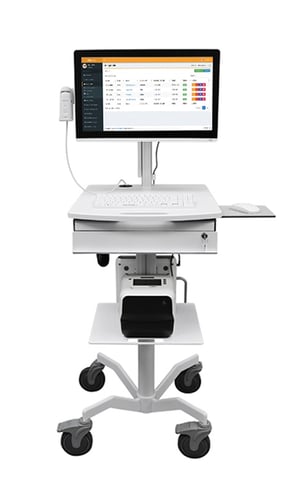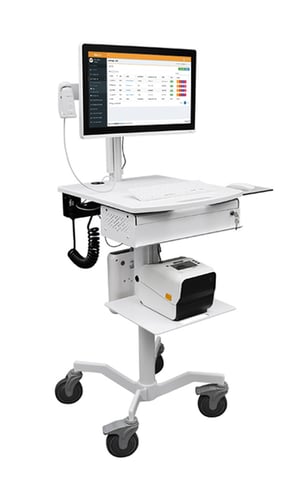By First Products on 4/29/22 8:00 AM
Telemedicine offers healthcare providers an excellent opportunity to better serve their patients, expand access to care, and achieve cost efficiencies.
However, launching a telemedicine program requires more than merely connecting to the internet, and many problems and obstacles are bound to crop up along the way. Fortunately, none of these issues are insurmountable, especially when medical entrepreneurs take the time to put appropriate strategies in place for overcoming them.
Reimbursement Issues
The adoption of telemedicine has expanded rapidly due to the COVID-19 pandemic. And while health insurers have been up-dating their policies to reflect this new reality, not all coverage changes have been made permanent and limitations may still exist in certain situations.
Healthcare entrepreneurs would be wise to research the reimbursement policy landscape in their state before deciding which telemedicine services to offer. Once services are up and running, it’s essential to have a reimbursement monitoring plan in place to avoid costly mistakes. A number of technology platforms are available to help providers track expenses, properly document receipts required by payers, and stay up to date on insurers’ allowable reimbursements.
.png?width=661&name=Untitled%20design%20(5).png)
Ensuring Patient Data Is Secure
Telehealth providers are subject to data privacy controls contained in HIPAA, HITECH, and other federal regulations. Failure to comply with these standards can result in significant fines EACH time a patient’s privacy is breached. To avoid costly data breaches, it’s crucial that providers follow these telemedicine best practices:
- Strong Method of Authentication: A telemedicine platform should offer a strong method for authenticating each individual’s identity every time they log on. Passwords should be strong, with a combination of upper case and lower-case letters, numbers and symbols. And they should never be posted on a monitor, bottom of a keyboard, in a file, or anywhere else others may be able to find them. For added security, practitioners might want to consider alternative methods of identification, such as biometrics or the use of multi-factor authentication.
- End-to-End Encryption: It’s vital that telehealth providers only use platforms that provide for end-to-end encryption. When properly configured and implemented, end-to-end encryption prevents unauthorized parties from listening in or otherwise intercepting remote interactions between clinicians and patients.
- Maintain a “Clean” Machine: Any laptop, mobile device, or desktop computer used to deliver telemedicine services should be equipped with the most up-to-date operating system, applications, security systems, and firmware. Public wi-fi systems should NEVER be used when transmitting or viewing patient records.
- Never Open Unfamiliar or Suspicious Emails: Healthcare providers and patients receive a large amount of phishing emails which may include malicious attachment and/or links that are intended to infect the recipient’s machine with malware. Never open an email that is unfamiliar or seems suspicious. When in doubt, it’s always best to click delete.
Licensing and Regulation
Telemedicine licensing and credentialing can be confusing, especially for providers who treat patients across state lines. Unfortunately, a lack of license portability continues to be a significant barrier to improving healthcare access through the use of telemedicine technology. The following resources provide information on various state telemedicine licensing requirements:
- The Telehealth Resource Centers website answers several frequently asked questions about Licensure and Scope of Practice and Credentialing and Licensing.
- The American Medical Association has up-to-date information on physician licensure requirements across all states and jurisdictions.
- The National Council of State Boards of Nursing offers licensure information and information about state boards of nursing.
- The American Telemedicine Association’s State Telemedicine Policy Center compiles state-specific information about telemedicine policy.


Lack of Integration
To keep things running smoothly, it’s essential that a telemedicine platform be able to integrate with a provider’s Electronic Health Records (EHR) system. This capability facilitates an efficient workflow and ensure all patients’ e-visits are properly documented and updated for future visits. A lack of integration, however, creates unnecessarily complicated workflows, increases the likelihood of mistakes, and contributes to frustration and dissatisfaction among staff.
Lack of Technical Support
Accessible and sustained technical support is essential to ensuring the success of a telemedicine program. If patients or staff aren’t able to easily navigate the application, they’re not going to use it. Before launching your program, look for vendors with robust IT support as part of their platforms and consider surveying patient to learn which devices they would be most comfortable using when accessing your telemedicine service. Then choose the platform that best aligns with their needs. It’s equally important to train your staff on using the platform, so they also can help patients who require assistance.
High Cost of Technology Outlays
Depending on your needs, the initial price tag for a telemedicine platform and associated equipment could be significant. Some of these expenses can be mitigated by choosing bundled services or those that offer a flat fee. As telemedicine continues to grow, technology expenses and service costs will begin to come down. Finally, keep in mind that virtual services have also been shown to reduce costs associated with in-person and ER visits for both providers and patients.
Patient Awareness
Telemedicine services won’t be of much value if patients aren’t even aware they’re an option. Invest in some content marketing and social media marketing to get the word out. If your practice or clinic maintains a blog or issues a newsletter (either electronically or via snail mail) use those platforms to publicize and explain your telemedicine services to your patients well before launch.
First Products: Your Partner in Telemedicine
First Products is ready to partner with medical entrepreneurs to ensure the delivery of quality telemedicine services. From mobile workstations to EMR/EHR charting technology, we offer a range of products and accessories are designed to help both clinicians and patients reap the benefits of today’s technological revolution in healthcare.
For more than 70 years, First Products’ unparalleled commitment to customer service, highly experienced sales support, dedication to long-term customer satisfaction, and industry-best warranties have earned us the trust and respect of doctors and nurses in the United States and around the world.
To learn more about how our customizable, perfect-fit solutions can ensure the success of your telemedicine program, please contact First Products at 800.854.8304.
_11wX8.5h-FINAL.png?width=721&name=FP-Logo-Horizontal-(COLOR)_11wX8.5h-FINAL.png)




comments